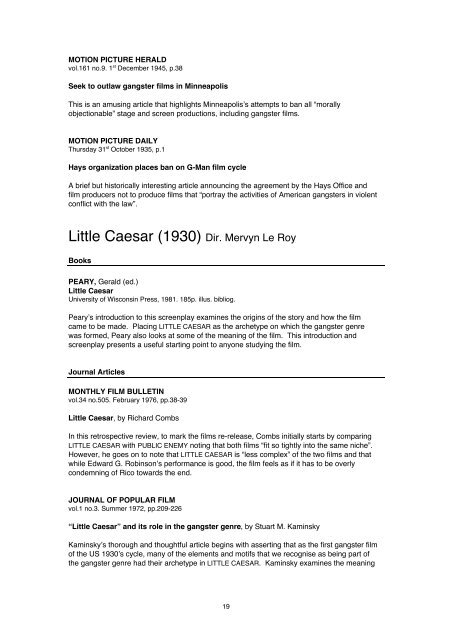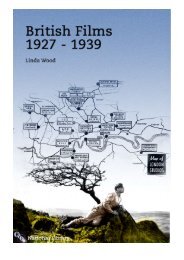16 + GUIDE - British Film Institute
16 + GUIDE - British Film Institute
16 + GUIDE - British Film Institute
Create successful ePaper yourself
Turn your PDF publications into a flip-book with our unique Google optimized e-Paper software.
MOTION PICTURE HERALD<br />
vol.<strong>16</strong>1 no.9. 1 st December 1945, p.38<br />
Seek to outlaw gangster films in Minneapolis<br />
This is an amusing article that highlights Minneapolis’s attempts to ban all “morally<br />
objectionable” stage and screen productions, including gangster films.<br />
MOTION PICTURE DAILY<br />
Thursday 31 st October 1935, p.1<br />
Hays organization places ban on G-Man film cycle<br />
A brief but historically interesting article announcing the agreement by the Hays Office and<br />
film producers not to produce films that “portray the activities of American gangsters in violent<br />
conflict with the law”.<br />
Little Caesar (1930) Dir. Mervyn Le Roy<br />
Books<br />
PEARY, Gerald (ed.)<br />
Little Caesar<br />
University of Wisconsin Press, 1981. 185p. illus. bibliog.<br />
Peary’s introduction to this screenplay examines the origins of the story and how the film<br />
came to be made. Placing LITTLE CAESAR as the archetype on which the gangster genre<br />
was formed, Peary also looks at some of the meaning of the film. This introduction and<br />
screenplay presents a useful starting point to anyone studying the film.<br />
Journal Articles<br />
MONTHLY FILM BULLETIN<br />
vol.34 no.505. February 1976, pp.38-39<br />
Little Caesar, by Richard Combs<br />
In this retrospective review, to mark the films re-release, Combs initially starts by comparing<br />
LITTLE CAESAR with PUBLIC ENEMY noting that both films “fit so tightly into the same niche”.<br />
However, he goes on to note that LITTLE CAESAR is “less complex” of the two films and that<br />
while Edward G. Robinson’s performance is good, the film feels as if it has to be overly<br />
condemning of Rico towards the end.<br />
JOURNAL OF POPULAR FILM<br />
vol.1 no.3. Summer 1972, pp.209-226<br />
“Little Caesar” and its role in the gangster genre, by Stuart M. Kaminsky<br />
Kaminsky’s thorough and thoughtful article begins with asserting that as the first gangster film<br />
of the US 1930’s cycle, many of the elements and motifs that we recognise as being part of<br />
the gangster genre had their archetype in LITTLE CAESAR. Kaminsky examines the meaning<br />
19









